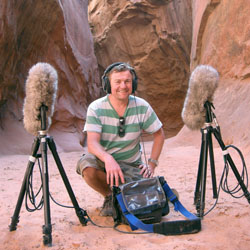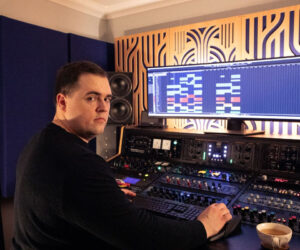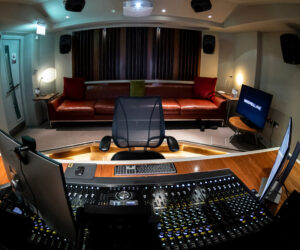Danny Boyle’s latest film, 127 Hours, recreates the ordeal of young mountaineer Aron Ralston, who gets trapped in a Utah canyon when a boulder slips, trapping his arm.
The soundtrack, which was nominated for a BAFTA and a Satellite in the Best Sound categories, was almost entirely recreated in post production.
A large selection of DPA microphones provided by UK distributor Sound Network was used extensively to record the dramatic tension and ambience of the surroundings.
Boyle has described 127 Hours as “an action movie in which the hero doesn’t move.” A challenge to film, and one that demanded a lot from its soundtrack.
The sound crew from Sound 24 included sound designer and supervising sound editor Glenn Freemantle, sound effects recordist Hugo Adams, Foley artists Nicolas Becker and Adam Mendez and Foley editor Jon Olive.
Adams was the only member of the crew to travel to Utah, spending 24 hours at the canyon recording the full audio picture of where the film had been shot. Recording during shooting was extremely difficult due to the noisy gyro-stabilized camera mounts being used.
“I was flown to Salt Lake City the day after the crew had wrapped on location,” explains Adams.
“My brief was to record atmospheres in and around the canyon over a 24-hour period, record spot FX at the spot where Aron Ralston was trapped, the Toyota Tacoma he drove out into the desert, and his mountain bike.
“I took a pair of DPA 4041 large diaphragms as my main atmosphere mics, because of their low noise floor and transparency. They were ideal in catching the remoteness of the desert location.”
“On arrival there was a blustery wind, so I put the 4041s into windshields and set about recording open desert winds. The 4041s perfectly handled the low end of a gust as well as the wispy high ends of sand flurries and juniper bushes.”
Adams recorded many different nuances of the wind whistling and humming through the canyon and left the 4041s recording in Ralston’s position in the canyon, returning later to record Foley tracks.
“Due to lack of space I had to put one of the 4041s up canyon and the other just below the location to record more ambient sounds, and I used a pair of 4023s in an X/Y configuration for close miking,” he says.
“We then recorded a number of spot FX and the sound of moving his equipment, eg rope, bag etc, to supplement the studio Foley. We did as many effects as we could, short of chopping off arms and breaking bones!”
The 4041s were left recording through to the next morning. Adams climbed back into the canyon during the early hours in order to change the battery pack. “The night was almost silent but what little sound there was beautifully captured with the 4041s; gentle wispy winds, light sand blowing, insects’ wings, etc.
“The following day was very still, so before dawn I used DPA 4023 compact cardioids to record some stereo atmospheres in the surrounding desert. After retrieving the 4041s from the canyon I did the same with them.”
Adams also used the 4041s for winds and eerie sounds in and amongst the rocks. They also proved useful in capturing the detail of winds through leaves.
The team then rigged up the stunt cyclist from the film with a pair of 4060 miniature omnis to get close up sounds of riding, jumping and skidding. “The benefit of the 4060s fitted with mini windjammers is that they can be placed anywhere without getting in the way,” says Adams.
“The recordings were very tight and punchy. We then rigged the 4041s and 4023s for recording tricks and jumps. The 4023s recording as stereo on a boom tracking the action and the 4041s placed for the approach to the jump and at the landing point or placed for passes, skids,etc.
“Back in SLC we took the Tacoma for a spin. I placed a 4060 on the tailgate just above the exhaust and another in the wheel arch. I also had the 4023s recording the interior. When we got out off the city we did a number of passes on a dirt track using the 4023s.”
Post production was handled back in the UK by Sound 24 and the Foley recorded at Anvil Studios, where a canyon had been constructed out of sandstone slabs and filled with 1.45 tons of sandstone and limestone boulders, to mirror the environment in Utah.
Adam Mendez and Nicolas Becker worked on the Foley using a pair of 4041 large diaphragm mics, a pair of 4060 miniature omnis, a 4006 omni and the DPA 8011 hydrophone, part of Becker’s much-used DPA arsenal.
“We used the 4041s to capture any subtle details that Glenn requested, such as the texture of the rock as Aron runs his hand over it, or the sound of ant footsteps in the sand,” says Mendez.
“Its low level noise floor and extremely high sensitivity made it ideal for this kind of recording, as it can capture the tiny nuances in a performance so that you don’t simply end up with a ‘noise’ but with a truly detailed sound.
“The 4006 is our workhorse, and we use it for a lot of the outdoors feet as it has a very focused sound for an omni mic, while still capturing a lot of air. The close miking grid is also very useful.
“A lot of the movie focuses on Aaron’s lack of water so Glenn wanted many different elements of water sounds, including his bottle and water bag. Most of these were based on sounds we recorded using the miniature hi-sensitivity 4060s.”
“These mics are fantastic for sticking into odd places as they have the DPA transparency and low noise floor and are also small enough to poke inside pipes and into bottles and even up noses!”




















